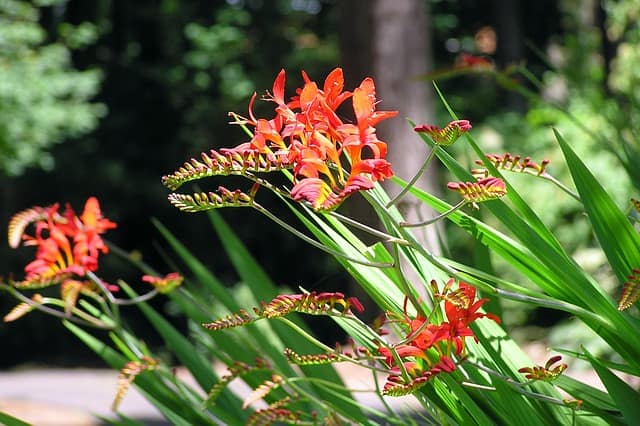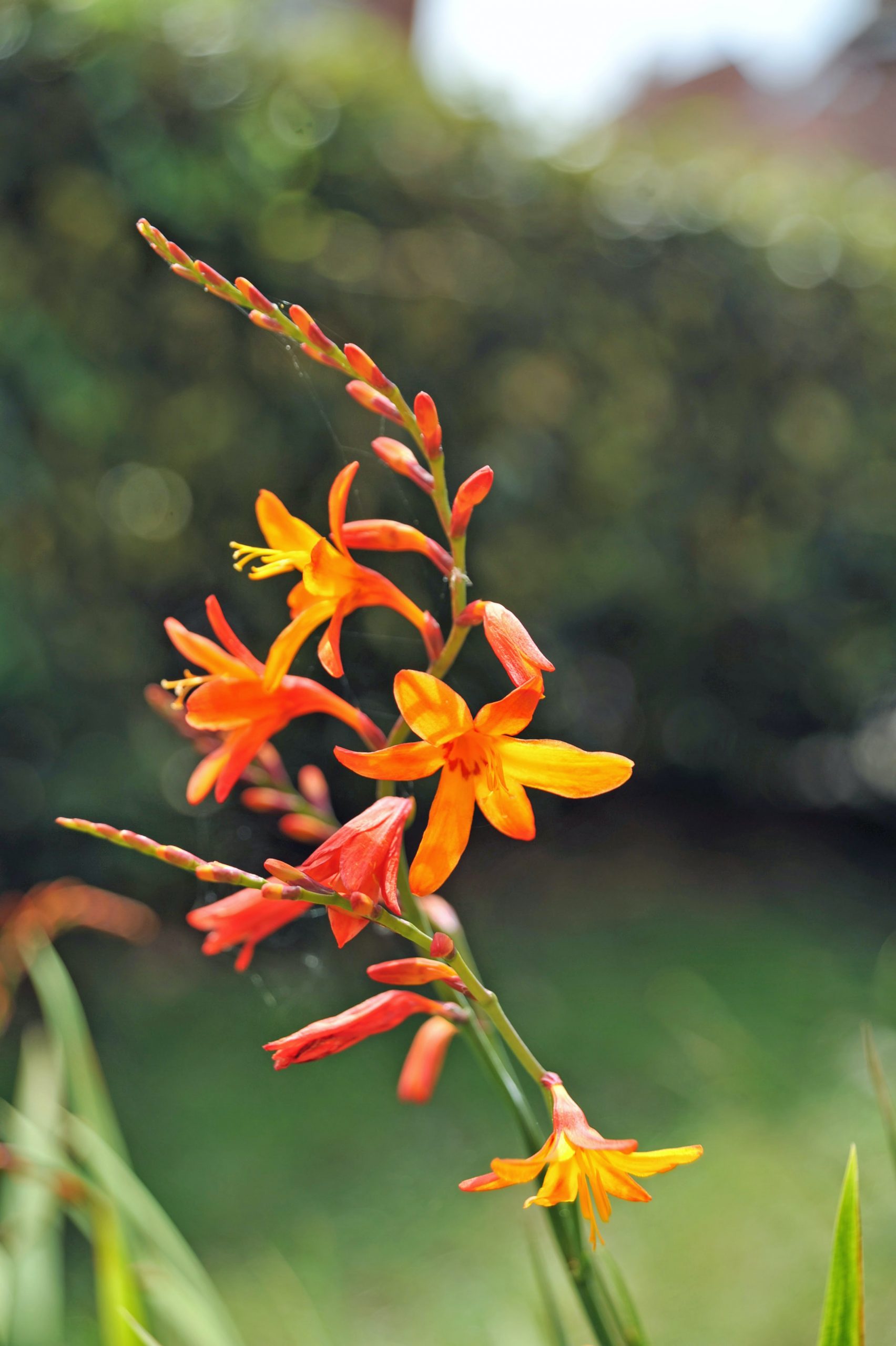
The perennial plant Crocosmia, commonly known as Monbretia or Copper Tips, blooms for about 8 weeks from July through September on established plants.
If your crocosmia isn’t blooming, it’s likely due to an excess of fertilizer, water stress, or lack of sunlight. Extra fertilizer encourages the growth of excessive foliage at the expense of flowering plants. After being planted, crocosmia also blooms more the following year.
Continue reading to find out how to put the best practices into practice so that your crocosmia has a better chance of flowering in the summer.
Table of Contents
Too Much Fertilizer (Foliage Growth at the Expense of Flowers)
The use of fertilizer is likely the most frequent cause of crocosmia not blooming in the summer.
The crocosmia in my garden (seen in this picture) has never received any additional fertilizer and blooms magnificently every year.
Crocosmia can grow with rich, robust foliage and few flowers because additional fertilizer encourages foliage growth at the price of flowers.
Crocosmia is a hardy plant that thrives in a wide range of soils (as long as they are well-draining), even blooming in South Africa’s nutrient-poor, stony soils.
Because crocosmia are not heavy feeders like roses are, major fertilizer treatments are typically at odds with their ideal environments.
It is significantly more effective to amend the planting area with compost, leaf mould, or well-rotted manure than to add fertilizer.
If your crocosmia has already been planted (and it would be too difficult to amend the soil at this point), applying mulch in the spring will ensure that the soil is evenly moist and will also contribute nutrients, which will help the crocosmia grow in the ideal circumstances for summer blooming.
Reduce whatever fertilizer you are using on your crocosmia.
It is doubtful that your crocosmia will bloom this season if you have previously applied the fertilizer, but there should be plenty of lush green foliage and the plant should still be in fine health.
Crocosmia are incredibly low maintenance plants that typically thrive when given a little bit of neglect. Crocosmia have a better chance of blooming the following year if they are patient.
Too Much Shade (Flowers best in full shade or partial sun)

Even while crocosmia plants in the same garden can bloom in partial shade and even full shade, the blooms are much less noticeable than those of crocosmia plants in full sun.
Crocosmia should be planted in full light to produce the most flowers.
Crocosmia tend to flower for longer when planted in partial shade in hotter climes, even though the intense sun in some regions (such the Mediterranean or Southern California) can shorten the longevity of the flowers.
Additionally, extreme heat and dry soil may cause water stress, which may prevent crocosmia flowers from blooming.
Crocosmia doesn’t have a particular preference for soil as long as it drains well, however in hotter climes, I would advise supplementing the soil with compost to help retain moisture and prevent drought.
Compost, leaf mould, or well-rotted manure can be added to crocosmia plants that have already been planted in hot areas to increase the soil’s ability to retain moisture, allowing the plants to flower without being stressed by drought.
Watering the crocosmia during the hottest weeks of the year can keep it healthy and provide it with the resources it needs to produce blossoms.
Crocosmia May not Flower in First Year

This typically occurs as crocosmia take some time to get used to their new surroundings.
Before purchasing your crocosmia, keep in mind that it was grown in a greenhouse or nursery with regulated temperatures, soil, sunlight, watering, humidity, etc.
After that, the crocosmia is planted in your garden, which can have some different environmental factors than what the plant was originally adapted to.
Crocosmia is not a difficult plant to grow, but it could take it a little while to settle in and get used to its new surroundings before it starts to bloom profusely.
Best Practices for Crocosmia Flowering
Your crocosmia should bloom after the first year with patience if it is:
- bright sun or partial shade when it is planted (full shade is best avoided).
- in times of drought gets some more water.
- not in need of fertilizer.
- Best planted in compost that drains properly (can tolerate acidic and alkaline soils– pH 6.5 to 7.5).
Dead-heading faded blooms on a regular basis promotes the growth of new flowers throughout the season. Crocosmia tends to bloom better when you don’t make a big deal out of it.
For more than ten years, the crocosmia in my garden has produced healthy flowers.
By letting the crocosmia leaves turn brown and provide a natural mulch in the fall, I have personally experienced great success in getting a stronger flower display every year.
Instead, remove the leaves when they naturally turn brown and add a compost mulch in the late fall because the leaves can look messy in the fall.
This should protect the bulbs from bitter winter temperatures, adding nutrients to the soil and giving the crocosmia a jump start on growing and blooming in the spring.
Key Takeaways:
- Too much fertilizer is the most frequent cause of crocosmias failing to blossom. Crocosmia doesn’t eat a lot. Crocosmia grows a lot of foliage but produces few flowers when overfed with fertilizer.
- Crocosmia blooms more in full sun or light shade. There are fewer flowers, but plenty of leaves, in the total shade.
- Due to transplant stress, crocosmia may not bloom in the first year after planting. After planting, crocosmia typically blooms more beautifully the following year.
- Crocosmia should be planted in compost, in full light, and during a drought. Mulch the bulbs during the winter to keep them warm and give them a jump start in the spring by not adding any fertilizer.
